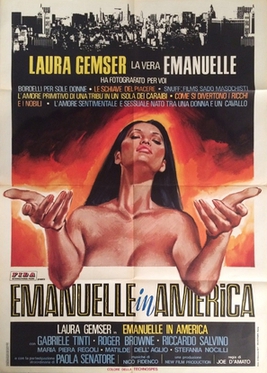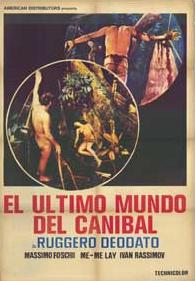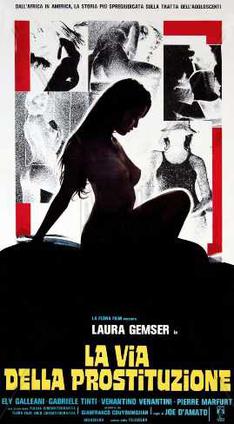
Laurette Marcia Gemser is an Indonesian-Dutch retired actress, model and costume designer. She is primarily known for her work in Italian erotic cinema, most notably the Emanuelle series. Many of her films were collaborations with directors Joe D'Amato and Bruno Mattei.

Aristide Massaccesi, known professionally as Joe D'Amato, was an Italian film director, producer, cinematographer, and screenwriter who worked in many genres but is best known for his horror, erotic and adult films.

Ruggero Deodato was an Italian film director, screenwriter, and actor.

Karin Schubert is a German actress. She appeared in film roles since 1970 and became a pornographic actress in the 1980s.
Cannibal films, alternatively known as the cannibal genre or the cannibal boom, are a subgenre of horror films made predominantly by Italian filmmakers during the 1970s and 1980s. This subgenre is a collection of graphically violent movies that usually depict cannibalism by primitive, Stone Age natives deep within the Asian or South American rainforests. While cannibalism is the uniting feature of these films, the general emphasis focuses on various forms of shocking, realistic and graphic violence, typically including torture, rape and genuine cruelty to animals. This subject matter was often used as the main advertising draw of cannibal films in combination with exaggerated or sensational claims regarding the films' reputations.

Black Emanuelle is a softcore sexploitation film from 1975 directed by Bitto Albertini. The film was set in Africa and shot mostly in Kenya. The music was composed by Nico Fidenco. Black Emanuelle was followed by a number of sequels, all revolving around the erotic adventures of Mae Jordan, a globe-trotting, hedonistic investigative journalist and photographer known to her readers as "Emanuelle". Her character has been described as "a strong and independent woman, sexually proactive, at the centre of wealthy young and old white men of power, and involved in any sort of depraved set and situation."

Emanuelle in America is a 1977 Italian sexploitation film, the third in the Black Emanuelle series starring Laura Gemser It is the second in the series to be directed by Joe D'Amato and has journalist Emanuelle investigate the production of snuff films, among other things. In some cuts, which were only released in certain markets, the film contains scenes of hardcore pornography, graphic violence and bestiality.

Ultimo mondo cannibale is a 1977 Italian cannibal exploitation film directed by Ruggero Deodato and written by Tito Carpi, Gianfranco Clerici and Renzo Genta. Starring Massimo Foschi, Me Me Lai and Ivan Rassimov, the plot follows a man trying to escape from a jungle island inhabited by a cannibal tribe.

Eaten Alive! is a 1980 Italian horror film directed by Umberto Lenzi. The film is about a young woman who is searching for her sister after her abduction by a cult in the jungles of New Guinea.

Trap Them was an American hardcore punk band formed in Salem, New Hampshire in 2001. They released five studio albums and five EPs, including a split EP with Extreme Noise Terror.

Emanuelle Around the World is a 1977 sexploitation directed by Joe D'Amato. The film stars Laura Gemser and George Eastman, Karin Schubert and Ivan Rassimov.
Adalberto "Bitto" Albertini (1924–1999) was an Italian film director and screenwriter.

Emmanuelle is the lead character in a series of French erotic films based on the protagonist in the novel of the same name, by Emmanuelle Arsan, written in 1959 and published in 1967.
Donal "Donald" O'Brien was an Irish film and television actor. In his near 40-year career, O'Brien appeared in dozens of stage performances and in more than 60 film and television productions.

Nieves Navarro García is a retired Spanish actress and fashion model. She worked extensively in Italian cinema appearing alongside actors such as Totò and Lino Banfi in the 1960's and 1970's. She later adopted the Anglicized stage name Susan Scott for many of her productions after 1969.

Gabriele Tinti was an Italian actor who was married to actress and model Laura Gemser.

Emanuelle in Bangkok is an Italian sexploitation film from 1976 starring Laura Gemser and Gabriele Tinti and directed by Joe D'Amato. It is the second in a series of films featuring the investigative journalist Emanuelle.

Emanuelle and the White Slave Trade is an Italian sexploitation film from 1978 directed by Joe D'Amato as his last Black Emanuelle film. It was also known as Emanuelle and the Girls of Madame Claude.
Fabrizio De Angelis is an Italian director, screenwriter and producer.

Caligula... The Untold Story is a 1982 historical exploitation film starring David Brandon and Laura Gemser. Written by George Eastman and Joe D'Amato, and produced, directed and shot by Joe D'Amato, it was created to cash-in on the success of Tinto Brass's Caligula without being a sequel or remake.















